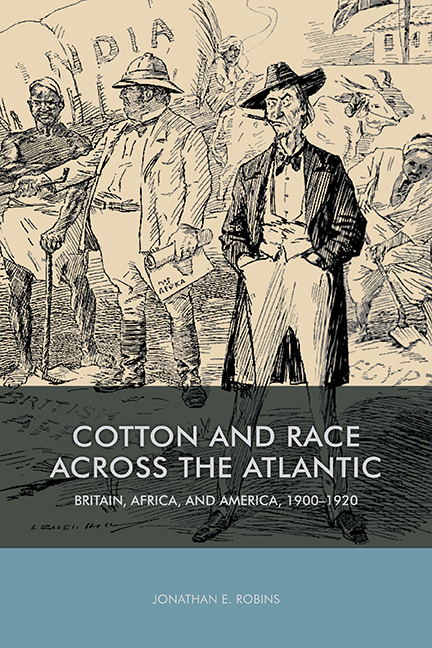Book contents
- Frontmatter
- Contents
- List of Illustrations
- Preface
- Abbreviations
- Introduction
- 1 The Cotton Crisis: Lancashire, the American South, and the Turn to “Empire Cotton”
- 2 “The Black Man's Crop”: The British Cotton Growing Association and Africa
- 3 “The Scientific Redemption of Africa”: Coercion and Regulation in Colonial Agriculture
- 4 “King Cotton's Impoverished Retinue”: Making Cotton a “White Man's Crop” in the American South
- 5 Cotton, Development, and the “Imperial Burden”
- Notes
- Bibliography
- Index
- Frontmatter
- Contents
- List of Illustrations
- Preface
- Abbreviations
- Introduction
- 1 The Cotton Crisis: Lancashire, the American South, and the Turn to “Empire Cotton”
- 2 “The Black Man's Crop”: The British Cotton Growing Association and Africa
- 3 “The Scientific Redemption of Africa”: Coercion and Regulation in Colonial Agriculture
- 4 “King Cotton's Impoverished Retinue”: Making Cotton a “White Man's Crop” in the American South
- 5 Cotton, Development, and the “Imperial Burden”
- Notes
- Bibliography
- Index
Summary
While commodity histories are prone to cliché statements about one substance or another “making the modern world,” it is an indisputable fact that we live in a world shaped by cotton. There is hardly a corner of our planet that is not somehow connected to the historical and contemporary processes of growing, manufacturing, and consuming cotton. The famous slogan of Cotton Incorporated, the marketing arm of America's Upland cotton growers, reminds us that cotton is “the fabric of our lives.”
Cotton is a remarkable fiber, but its ubiquity in textiles and a host of other products is largely due to its low cost. The struggle for low-cost goods has left its mark across the world. In Lancashire, once the dominant center of cotton manufacturing, the brick shells of mills sit empty, awaiting demolition or redevelopment; meanwhile in sites as far-fl ung as Bangladesh and Haiti, new mills are being erected in pursuit of cheap labor and preferential access to tariff-protected markets in the United States and Europe. The impact of global economic change on cotton agriculture has been less visible, but certainly no less significant. It leaves no urban ruins awaiting transformation into loft apartments, nor does it create sudden (and soon-forgotten) disasters like the 2013 Rana Plaza collapse. We are beginning to take notice of the slow-moving disasters brought by cotton, however, like the desiccation of the Aral Sea. Even my home on Lake Superior, far from the sunny cotton fields of the American South, suffers from the search for cheap cotton: poisonous chemicals like toxaphene have migrated from dusty southern cotton fields to northern lakes, accumulating in the fish we eat.
Cotton agriculture has created human disasters of debt, poverty, and even famine, but it has also brought wealth to farmers around the globe. Today's cotton farmers constitute three distinct classes: one, concentrated in the United States, operates a highly mechanized, capital-intensive industry, protected by an array of federal regulations, subsidies, and tariffs. The second class, spread across the globe from Africa to Asia to Latin America, labors by hand to cultivate and harvest cotton, forced into competition not only with fellow peasant farmers, but also against highly mechanized American farmers. Between the two is a large and still-growing body of laborers in state-run and private-sector mechanized cotton projects in central Asia, Latin America, and increasingly, sub-Saharan Africa.
- Type
- Chapter
- Information
- Cotton and Race across the AtlanticBritain, Africa, and America, 1900–1920, pp. ix - xiiPublisher: Boydell & BrewerPrint publication year: 2016
- 1
- Cited by



